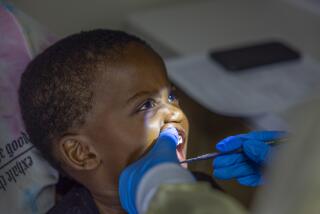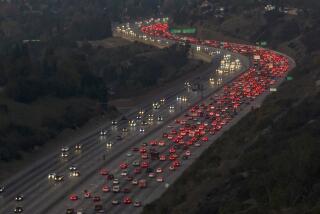Number of Californians Not Covered by Health Insurance Jumps 50%
- Share via
The number of Californians without any kind of health insurance jumped 50% in the seven years ending in 1986, according to a study released Monday by the UCLA School of Public Health.
Working people, along with their spouses and children, accounted for 80% of the 5.1 million Californians under age 65 who had no private medical insurance, no Medicare and no Medi-Cal coverage during 1986, the study reports. This compares with 3.5 million people in 1979.
“The problem of the uninsured already has reached crisis proportions,” researchers concluded. “It requires the immediate attention of public policy makers.”
Of the 50% increase in the state’s uninsured population, about half can be attributed to the state’s population growth, the researchers reported. But the other half is “due to the decreasing rate of health insurance coverage.”
Fringe Benefit
Traditionally, workers have received health insurance as a fringe benefit of their employment. But in the last decade, there has been a decline in employers providing health insurance, said E. Richard Brown, associate professor of public health at UCLA and principal investigator of the study.
At a time of mounting legislative concern about holes in the nation’s health care network, the UCLA study documents the dramatic increase in California’s uninsured population and analyzes who is affected--by age, race, income and type of employment.
Of all age groups, young adults between 18 and 29 were hardest hit. Latinos, both adults and children, experienced the steepest rise of any ethnic group. As for the general work force, those employed in service, retail, construction and agricultural jobs were the least likely to get health insurance as a fringe benefit of their employment.
“This report shows that our health care system in California is in desperate trouble,” said Assemblyman Burt Margolin (D-Los Angeles), who has introduced legislation aimed at helping uninsured workers. “A long-term solution to the problem is dependent upon tackling the challenges raised by this uninsured population.”
Researchers billed the report as helpful in identifying continuing trends that are central to “predicting what will happen in the future.”
“It seems that employers are less and less likely to offer health insurance,” Brown said. “All the things that are causing the problem seem to be continuing unabated.”
The study builds on research by the same UCLA group that reported 10 months ago that Californians in 1985 were less likely than other Americans to have health insurance of any kind and that adults living in Los Angeles and San Diego are the least likely of all to have this protection.
The 1986 figures show a slight drop from the year before in the uninsured statewide, but Brown said the decline was so small that it was “not statistically significant.”
The 5.1 million Californians without health insurance represent more than 21% of the state’s population under age 65, according to the report. (Nearly all people over 65 and disabled people under 65 are covered by Medicare.) This compares with about 17.6% of the non-elderly population nationwide.
‘Difficult Time’
“These children and adults have a difficult time getting any medical care,” Brown said. Previous studies have found that uninsured people are less likely to get their young children adequately immunized, to receive prenatal care during the critical, early months of pregnancy and to see a doctor when they have serious symptoms.
“They have very limited resources to pay for care and turn to the county hospitals and other overburdened systems . . . (that) don’t have enough money to pay for the care of all these people in need,” Brown said.
The researchers noted that public spending has not kept pace with the growth of the state’s uninsured population. During a recent three-year period, the amount of public money spent per medically indigent patient in California fell 9%, researchers asserted.
As a result, both public and private hospitals have had to absorb higher charity care costs.
“More and more private hospitals have closed their trauma centers and shut their doors to rescue ambulances in an effort to decrease their financial burdens resulting from uninsured patients,” the report stated. “The problem is likely to worsen as the number of AIDS patients, including those who are medically indigent, increases during the next few years.”
Tighter Restrictions
Analysis of the growing number of uninsured Californians by the state Senate’s Health and Human Services Committee has attributed the phenomenon to several factors, including tighter restrictions on eligibility for government-sponsored health care programs and a continuing shift of jobs to service industries, where health benefits are decreasing.
To help assure medical coverage for workers, other states--such as Hawaii and Massachusetts--have enacted laws requiring employers to provide health insurance. Similar efforts in California have died in the state Legislature.
At the federal level, two bills have been introduced that would require businesses to provide health insurance for all employees who work more than 17 hours week. A measure sponsored by Sen. Edward M. Kennedy (D- Mass.) and Rep. Henry A. Waxman (D-Los Angeles) would cost employers between $27 billion and $39 billion annually, it has been estimated.
Among all age groups, the UCLA researchers found that the percentage of young adults without health insurance increased most dramatically, from 22% to 30%.
Uninsured Children
Overall, the percentage of uninsured children under age 16 remained about the same, totaling more than 1.3 million. Of these, black and Latino children were far more likely to lack medical insurance in 1986 than in 1979, while their white and Asian counterparts were less likely to go without coverage. More than 33% of all Latino children in California lacked health insurance in 1986, up from 23% in 1979.
More than 29% of all black children were uninsured, up from 18%. Especially troubling, researchers noted, was that the biggest jump occurred during a one-year period, between 1985 and 1986. Black adults also showed a sudden jump, from 19% to 25%.
Researchers were unable to explain the sharp upswing among blacks, saying that it may indicate “a dramatic change in the trend, a one-year anomaly or sampling error.”
The study noted that the uninsured include children and family members of all ethnic groups, as well as people of varying incomes, ranging from below the poverty line to 300% above it. But the highest percentages of uninsured were clustered just above the poverty level, defined as a family of four earning up to $11,200.
More to Read
Sign up for Essential California
The most important California stories and recommendations in your inbox every morning.
You may occasionally receive promotional content from the Los Angeles Times.










